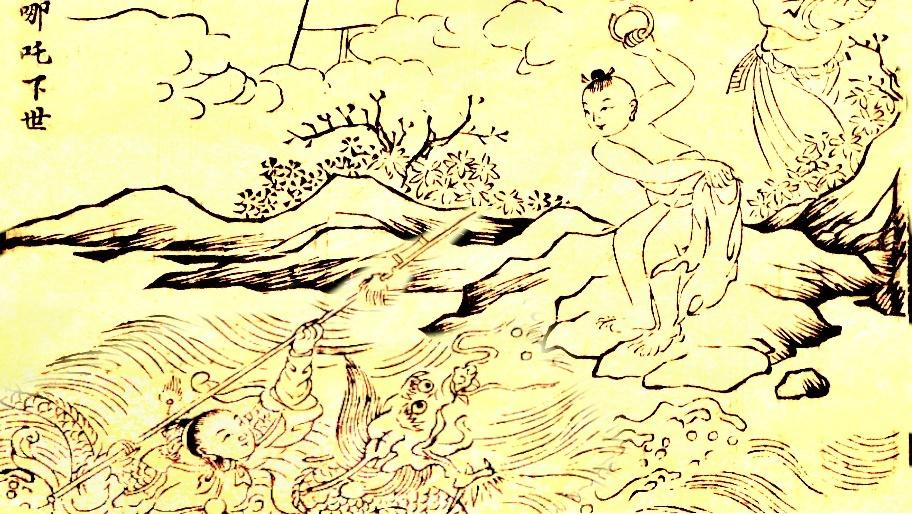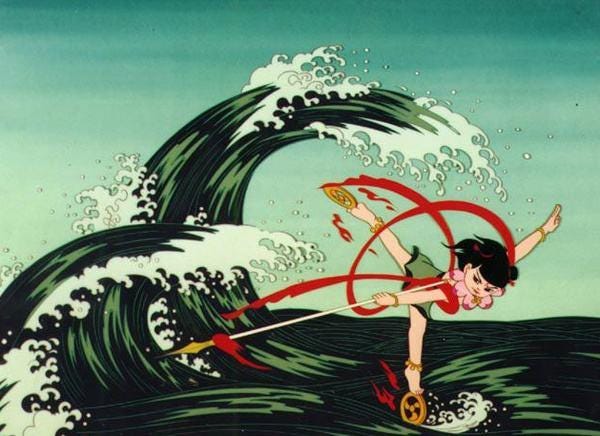A child stands at the edge of the Eastern Sea, his spear burning with divine fire. The Dragon King rises, waves crashing, yet the boy does not retreat. This is Nezha, the rebel warrior of Chinese mythology. But the Nezha we see today is not the Nezha of old…
With Nezha 2: The Dragon King’s Wrath now released, audiences worldwide are witnessing yet another evolution of this legendary figure. But behind the stunning animation lies a story that stretches back over a thousand years,from Buddhist scriptures to Daoist legends, from ancient folklore to modern cinema.
Western audiences may recognize Nezha as the hotheaded, mischievous warrior from Investiture of the Gods or his modern animated adaptations, but who was he before the movies? And why does his legend still resonate today?
The Ancient Origins of Nezha: From Buddhist Protector to Daoist Warrior
Nezha wasn’t always the rebellious teenage deity known for riding fire-wheels and battling dragons. His origins trace back to ancient India, where he first appeared in Buddhist texts as Nalakubara 那拏天, a son of Vaiśravaṇa, the guardian of the north.

As Buddhism spread into China, Nezha’s name began appearing in Tang Dynasty (7th-10th century) Buddhist stories, where he was depicted as a celestial prince with great powers. Over time, his legend merged into Chinese Daoist mythology, blending with local beliefs and evolving into the rebellious child-warrior we recognize today.
But it wasn’t until the Ming Dynasty (14th-17th century), with the novel Investiture of the Gods 封神演义, that Nezha’s most famous story took shape. The tale of a boy who defied destiny, fought the Dragon King, and ultimately sacrificed himself in an act of self-liberation.

A Rebellious Spirit: Nezha’s Story in Investiture of the Gods
Nezha is often compared to Sun Wukong, the Monkey King, another mythological trickster. But while Sun Wukong defied the heavens out of pride, Nezha’s defiance was deeply personal.
Born as the third son of General Li Jing, Nezha was no ordinary child. He was the reincarnation of a divine spirit, the Lotus Pearl, meant to aid the gods in their celestial war. But his powers made him reckless. In a moment of anger, he killed the Dragon King’s son, Ao Bing, setting off a chain of divine punishment.
When his father refused to protect him, Nezha did the unthinkable: he took a sword, cut off his own flesh to return it to his mother, and scraped off his bones to return them to his father. It was an act of both ultimate defiance and tragic self-sacrifice—a child severing himself from the very people who brought him into the world.
Yet, Nezha’s story didn’t end there. His master, Taiyi Zhenren, resurrected him in a new body sculpted from lotus flowers, reborn stronger than ever. Now free from his mortal ties, Nezha became a warrior-god, wielding his famous fire-tipped spear, wind-fire wheels, and universe rings to battle his enemies.
His tale is one of self-determination, of fighting against fate, even when fate is written by the gods themselves.
Nezha’s Evolution: From Myth to Cinema
Over the centuries, Nezha has transformed through opera, folklore, and animation, evolving with each retelling. The 1979 animated film Prince Nezha’s Triumph Against the Dragon King introduced him to mainstream audiences, portraying him as an anti-establishment hero.
Fast-forward to 2019, and Nezha: Birth of the Demon Child completely reimagined the legend, giving us a rebellious underdog fighting against his dark destiny. The film shattered box office records and reshaped Nezha for modern audiences.
And now, in 2024, Nezha 2: The Dragon King’s Wrath expands his story further. This time, the narrative shifts, Nezha and Ao Bing, once destined enemies, form an uneasy alliance to battle forces greater than themselves.
One of the most striking reimaginings in Nezha 2 is his sacrifice scene, instead of physically cutting off his flesh, Nezha is bound by a spell called the Heart-Piercing Curse, where thousands of needles tear through his body, a visually stunning yet deeply painful metaphor for his original act of self-destruction.
This shift from revenge-driven defiance to sacrifice driven by love marks a new evolution in Nezha’s character, one that resonates with modern audiences while staying true to his mythological core.
Why Does Nezha Matter Today?
Nezha’s story continues to be retold because it taps into something universal: the struggle between duty and self-identity, between family expectations and personal freedom. His legend mirrors timeless themes: youthful rebellion, self-sacrifice, and ultimately, transformation.
Whether as a Buddhist protector, a Daoist warrior, or a cinematic icon, Nezha’s story is one of reinvention, a legend that, much like the boy-god himself, refuses to fade away.
If you’ve enjoyed this journey into myth and legend, you’ll love The Ink Pavilion. I write historical fantasy and cultural deep dives that bring the lost worlds of ancient China to life.
Subscribe to explore forgotten gods, haunted palaces, and the echoes of a past that still speaks.




